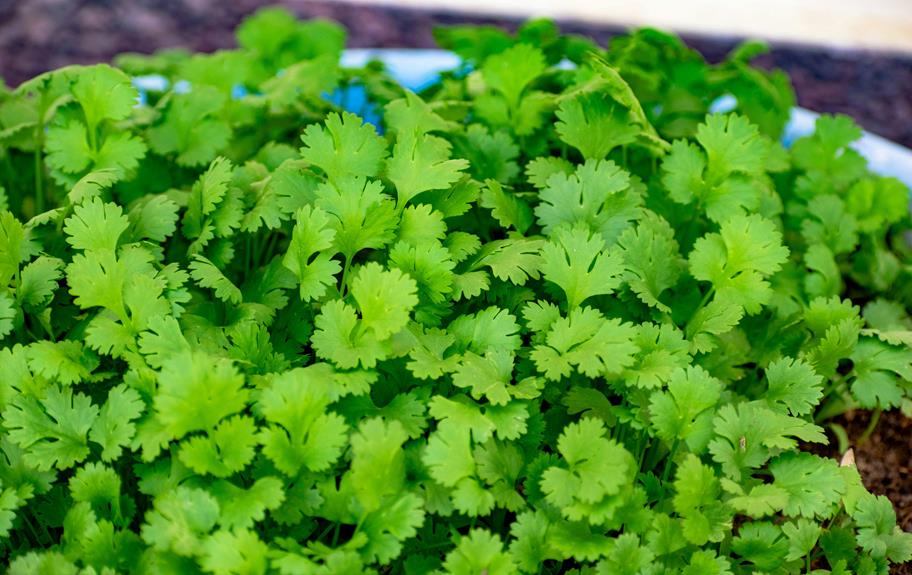Growing cilantro in your Aerogarden can be a rewarding venture, especially if you're keen on having fresh herbs at your fingertips. You'll start by selecting seed pods that are specifically designed for your Aerogarden model. Once you've got your pods, you'll need to plant the seeds carefully and set up the LED lights to make sure they receive the best amount of daily light. However, the key to lush, flavorful cilantro lies not just in how you start, but in how you manage the growth process. Are you aware of the important steps for pruning and water management that can have a significant impact on your cilantro's quality and yield?
Key Takeaways
- Select high germination rate cilantro seed pods compatible with your Aerogarden model.
- Plant seeds evenly in pods and insert securely into the grow deck.
- Set the Aerogarden's LED lights to provide 14-17 hours of light per day.
- Maintain water levels above the fill line and use distilled or filtered water.
- Regularly prune mature cilantro leaves and harvest the top one-third of the plant.
Choosing Your Aerogarden Model
Selecting the right Aerogarden model is essential for successfully growing cilantro indoors. You've got to take into account the size and features that'll match your needs and aspirations. It's not just about picking any model; it's about harnessing control to optimize growth and yields.
First, evaluate the space you've dedicated to your indoor gardening. If you're limited, models like the Aerogarden Sprout or Harvest might be right up your alley. They're compact, fitting neatly on most countertops.
However, if you're aiming for a larger crop or perhaps diversifying later, consider the Bounty or the Farm models. These offer more pod spaces and greater light adjustments, which are important for scaling up.
Think about the control features. Models with Wi-Fi capabilities, like the Bounty Elite, allow you to monitor and adjust settings right from your smartphone. This means you can tweak light intensity, water delivery, and nutrient distribution on-the-go, ensuring your cilantro receives exactly what it needs without constant manual checks.
Your choice dictates your journey in cilantro cultivation. By choosing wisely, you're not just growing cilantro, you're mastering the art of indoor gardening, ensuring every sprig of cilantro flourishes under your watchful eye.
Selecting Cilantro Seed Pods
Once you've chosen your Aerogarden model, you'll need to pick the right cilantro seed pods to guarantee a robust and flavorful harvest. Selecting the best seed pods isn't just about grabbing any packet off the shelf; you're aiming for seeds that offer the highest germination rate and the best yield.
Here's a quick guide to choosing cilantro seed pods:
| Feature | Importance | What to Look For |
|---|---|---|
| Germination Rate | High | Pods that guarantee above 85% success |
| Pod Compatibility | Essential | Specific to your Aerogarden model |
| Organic Certification | Preferable | Certified organic seeds |
First, focus on the germination rate. This percentage tells you how likely it is that the seeds will sprout, which is essential for planning your cilantro crop. You don't want to waste time on pods that won't sprout. Next, make sure the pods are compatible with your specific Aerogarden model. Some pods are designed for particular models and might not fit or function well in others.
Lastly, consider opting for organic seed pods. They're not just good for your health; they align with eco-friendly gardening practices. By choosing wisely, you're in control of not only the growth of your herbs but also the quality and safety of your harvest.
Setting Up Your Aerogarden
After choosing your cilantro seed pods, it's time to set up your Aerogarden. First, you'll want to choose a suitable location. It's important that you place your Aerogarden where it won't be disturbed and has access to a power outlet. Consider the environment; excessive sunlight or drafts can affect the growth of your cilantro. You're in control here, so pick a spot that guarantees stability and ideal growing conditions.
Next, assemble your Aerogarden according to the manufacturer's instructions. Make sure every part is securely attached and functioning. This is your growth hub; everything must be precise to avoid issues later.
Check the water basin and ensure it's clean before filling it with water. The quality of water matters, so if your tap water is hard or heavily chlorinated, using distilled or filtered water can be a better choice. You're setting the foundation for your cilantro's growth, so make each step count.
Planting Cilantro Seeds
Now that your Aerogarden is set up, it's time to plant your cilantro seeds. You'll want to take charge of this process to ensure ideal growth.
Begin by selecting high-quality cilantro seeds. Place them in the seed pods provided with your Aerogarden. It's important that you distribute the seeds evenly across the pods to avoid overcrowding, which can impede growth.
Press the seeds gently into the grow media, making sure they're not too deep—a light cover is sufficient. This precision in planting depth is essential for ensuring that your cilantro seeds have the proper environment to sprout effectively.
Once the seeds are in place, insert the pods into your Aerogarden's grow deck. Make sure each pod is securely fitted into its slot to avoid any displacement.
Label each pod. This step isn't just about organization—it's about taking command of your growing process and monitoring the development of each plant. Keeping track of their progress allows you to make informed decisions as they grow.
Managing Light and Water
Managing the lighting and water levels in your Aerogarden is essential for the healthy growth of your cilantro. Cilantro thrives under a specific light and water regimen, and you're in control of ensuring it gets just what it needs.
Your Aerogarden's LED lights should be set to provide 14-17 hours of light daily to mimic the ideal growing conditions. It's vital to monitor this closely, as insufficient light can lead to spindly plants, while too much can cause stress.
Water management is equally critical. Your Aerogarden will alert you when it's time to add water, but it's wise to check the water levels regularly. Cilantro prefers a consistently moist environment, so never let the water level drop below the fill line.
Also, consider the quality of water you use. Hard water can lead to mineral buildup that may hinder plant growth. Using distilled or filtered water can prevent these issues and give you more control over the mineral balance your cilantro receives.
Pruning and Maintenance
Regularly pruning your cilantro will promote fuller, healthier growth and prolong its harvest period. To maintain control and guarantee your plant thrives, start by identifying the mature leaves. These are typically larger and closer to the base. Snipping these off not only encourages new growth but prevents your cilantro from becoming leggy and sparse.
Use clean, sharp scissors for pruning. This reduces stress on the plants and helps prevent the spread of disease. You'll want to aim for a cut just above a leaf node or junction, where new stems will sprout. By cutting here, you're directing the energy of the plant back into producing more compact and lush foliage, rather than letting it expend efforts on just a few elongated stems.
Be mindful not to over-prune; you should only remove about one-third of the growth at any one time. This technique allows the plant to recover more quickly and continue growing robustly. Additionally, regularly check for yellowing or dead leaves and remove these promptly. Such maintenance not only keeps your cilantro looking tidy but also minimizes the risk of disease.
Harvesting Your Cilantro
Begin harvesting your cilantro once the leaves are lush and full, typically a few weeks after planting. You'll want to approach this with precision to maximize yield and promote further growth. Here's how you'll take control of the process:
Snip the leaves gently from the top using sharp scissors. Don't pull the leaves as it can harm the plant. Aim to cut about one-third of the plant at a time, which encourages new growth while maintaining a steady supply for your kitchen.
Here's a quick guide to help you manage the harvesting process efficiently:
| Week | Plant Height | Harvesting Method |
|---|---|---|
| 3-4 | 3-5 inches | Light trimming |
| 5-6 | 5-7 inches | Moderate cutting |
| 7-8 | 7+ inches | Heavy harvest |
| 9-10 | Maintain | Regular trimming |
| 11+ | Monitor | As needed basis |





Konnichiwa! (Hello!) I'm Pat Tokuyama, a Japanese tofu cookbook author, who travels for music, food, and adventure. If you like Japanese tea, checkout some of the newestorganic japanese tea, matcha bowls and noren and more!
** Curious about the Plant Based Japanese Cooking Club? ** Learn more here!